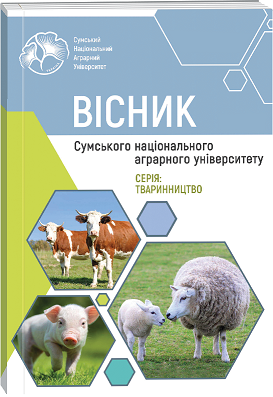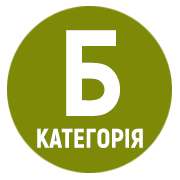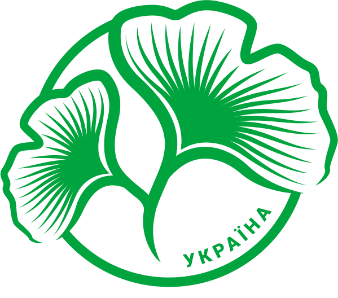THE DEPENDENCE OF THE REALIZATION OF THE GENETIC POTENTIAL OF PIGS ON THE CONDITIONS OF CARE AND FEEDING
Abstract
Today's pig farming is a high-tech hobby, where the success of breeding largely lies in the diversity of minds, reducing the genetic potential of animals. The productive capacity of pigs is determined not only by their sluggishness, but also by adhering to technological standards such as balanced yearning, microclimate and veterinary prevention. Lack of attention to these minds can lead to a decrease in productivity, loss of life quality and stress syndromes in animals, which is negatively associated with end products. Particular attention must be paid to the specific needs of genotypes that have high productive potential and are also sensitive to external factors. It has been found that minor changes in optimal technological parameters in which the breed is formed or a synthetic line can significantly reduce the level of productivity. For example, current maternal lines of sows demonstrate high fertility and efficiency of feed conversion, and farmed pig farms will not always provide realizing this potential. The article is devoted to the influence of genetic and technological factors on the productivity of current breeds and hybrids of pigs. The delay in the implementation of the recession potential of animals in the minds of maturation, yearling, veterinary prevention and microclimate is analyzed. It is understood that minimal adherence to technological standards can lead to a decrease in productivity. The role of modern methods of genetic selection, genomic selection and DNA screening, which allow increasing the efficiency of breeding robots, is closely examined. The use of such technologies by leading international companies is being instituted. The authors appreciate the importance of adapting brains to the specific characteristics of new genotypes, maintaining temperature conditions, feeding programs and veterinary control. It is clear that the successful development of natural genetics in pig breeding requires an integrated approach, which includes technological adaptation of all genetic processes. Unsystematic changes or neglect of necessary factors can lead to the loss of productive performance and economic savings. Therefore, highly productive pig farming will require a comprehensive approach, which includes genetic monitoring, optimization of mental health, proper yearling management and veterinary care. The transition to new genetics is accompanied by the adaptation of the entire reproductive system to effectively unlock the potential of animals. A systematic approach allows us to achieve stable productivity and economic profitability in livestock farming.
References
2. Biriukova I. (2019). Svynarske hospodarstvo “Uhryniv Ekofermf”, shcho na Lvivshchyni, zbyraietsia postachaty yakisnyi henetychnyi material ukrainskym svynariam: zhurnal The Ukrainian Farmer. [Pig farming "Ugryniv Ekoferma", located in the Lviv region, is going to supply quality genetic material to Ukrainian pig farmers: The Ukrainian Farmer magazine].
3. Bryk M. M. (2018). Suchasnyi stan ta perspektyvy rozvytku haluzi tvarynnytstva v Ukraini. Ekonomichnyi analiz. [The current state and prospects for the development of the livestock industry in Ukraine. Economic analysis] https://www.econa.org.ua/index.php/econa/article/view/1649/6565656727
4. Bublyk O. (2023). Svynari spodivaiutsia na vidnovlennia popytu na pleminnykh tvaryn: zhurnal The Ukrainian Farmer. [Pig farmers hope for a revival of demand for breeding animals: The Ukrainian Farmer magazine].
5. Bublyk, O. (2024). Zmina hodivli svynei iz sukhoi na ridku zaoshchadzhuie do 12% kormiv. Agrotimes. Tvarynnytstvo [Changing pig feeding from dry to liquid saves up to 12% of feed. Agrotimes. Animal husbandry]. URL: https://agrotimes.ua/tvarinnitstvo/zmina–godivli–svinej–iz–suhoyi–na–ridku zaoshchadzhue–do–12–kormiv (in Ukrainian)
6. Douglas, S. L., Szyszka, O., Stoddart, K., Edwards, S. A., Kyriazakis, I. (2015). Animal and management factors influencing grower and finisher pig performance and efficiency in European systems: a meta–analysis. Anim. 9(7). URL: https://www.sciencedirect.com/science/article/pii/S1751731115000269
7. Hansen, C. (2021). Brancheanalyse for produktivitet i udsnit af DanBred–besætninger 2019 [Industry analysis for productivity in a sample of DanBred herds 2019]. Notat nr. 2105, SEGES Svineproduktion. URL: https://svineproduktion.dk/publikationer/kilder/notater/2021/2105
8. Hyttel, H. L. (2024a). Brancheanalyse for produktivitet i 2023 i et udsnit af besætninger somanvendte DanBred–genetik [Industry analysis for productivity in 2023 in a sample of herds that used DanBred genetics], Note no. 2410, SEGES Innovation. URL: https://www.landbrugsinfo.dk/–/media/landbrugsinfo/public/5/7/1/notat_2410_productivity_danbred_farms_2023.pdf
9. Karaieva, N. V., Varava, I. A. (2016). Ekoloho–ekonomichna optymizatsiia vyrobnytstva: metody ta zasoby statystychnoho prohnozuvannia [Ecological and economic optimization of production: methods and means of statistical forecasting] NTUU “KPI”, 80 p. URL: https://ela.kpi.ua/server/api/core/bitstreams/a4cbba78–2c9f–46f4–b24e–348d030e117d/content (in Ukrainian)
10. Khalak, V. I., & Gutyj, B. V. (2022). Riven fenotypovoho proiavu hodivelno-miasnykh yakostei molodniaku svynei riznoi vnutrishnoporodnoi dyferentsiatsii za deiakymy bahatokomponentnymy pokaznykamy otsinky. [Level of phenotypic manifestation of feeding and meat qualities of young pigs of different intrabreed differentiation according to some multicomponent evaluation indexes]. Ukrainian Journal of Veterinary and Agricultural Sciences, 5(1), 66–70. (in Ukrainian). https://doi.org/10.32718/ujvas5-1.11
11. Khramkova, O. M. Povod, M. H. (2017). Vidhodivelna produktyvnist hibrydnoho molodniaku svynei vitchyznianoho ta zarubizhnoho pokhodzhennia [Feeding productivity of hybrid young pigs of domestic and foreign origin]. Bulletin of the Sumy National Agrarian University: "Animal Husbandry" Series, 7(33), 226–232. URL: http://www.irbisnbuv.gov.ua/cgibin/irbis_nbuv/cgiirbis_64.exe?I21DBN=LINK&P21DBN=UJRN&Z21ID=&S21REF=10&S21CNR=20&S21STN=1&S-21FMT=ASP_meta&C21COM=S&2_S21P03=FILA=&2_S21STR=Vsna_tvar_2017_7_44 (in Ukrainian)
12. Kravets I. V. (2018). Suchasni tendentsii rozvytku vyrobnytstva svynyny v Ukraini ta sviti: elektronne naukove fakhove vydannia “Efektyvna ekonomika”. [Modern trends in the development of pork production in Ukraine and the world: electronic scientific publication "Effective Economy"].
13. Liakhovskyi I. (2023). Rozvytok eksportu dopomozhe pidpryiemstvam mʼiasnoi haluzi v period viin: informatsiine ahentstvo “Interfaks Ukraina”. [Export development will help meat industry enterprises during the war: Interfax Ukraine news agency]. https://interfax.com.ua/news/press-release/933250.html
14. Lund, H. H. (2024). Landsgennemsnit for produktivitet i produktionen af grise i 2023 [National average for productivity in the production of pigs in 2023]. Notat nr. 2408, SEGESI nnovation. URL:https://www.landbrugsinfo.dk/public/3/1/0/management_landsgennemsnit_produktion_grise_2023
15. Maslak Oleksandr (2012). Svynarstvo – tradytsii ta prybutkovyi biznes: Zhurnal ta multymediina platforma “Ahrobiznes sohodni”. [Pig farming – traditions and profitable business: Magazine and multimedia platform "Agrobusiness today"]. (in Ukrainian) https://agro-business.com.ua/agro/ekonomichnyi-hektar/item/7831-svynarstvo-tradytsii-ta-prybutkovyi-biznes.html
16. Mykhalko, O. G. (2020). Vidhodivelni yakosti svynei irlandskoho pokhodzhennia pry riznykh typakh hodivli [Fattening qualities of Irish pigs origin at different types of feeding]. Bulletin of the Sumy National Agrarian University. Series "Livestock", 3(42), 52–57. (in Ukrainian). https://doi.org/10.32845/bsnau.lvst.2020.3.9
17. Mykhalko, O. G. (2021). Suchasnyi stan ta shliakhy rozvytku svynarstva v sviti ta Ukraini [The current state and ways of development of pig farming in the world and in Ukraine]. Bulletin of the Sumy National Agrarian University. Series “Livestock”, 3, 60–77. https://doi.org/10.32845/bsnau.lvst.2021.3.9 (in Ukrainian)
18. Povod, M. H., Izhboldina, O. O., Nechmilov, V. M., Mykhalko, O. G., Zhyzhka, S. V. (2018). Sezonna produktyvnist hibrydnoho molodniaku svynei za riznykh typiv hodivli [Seasonal productivity of hybrid young pigs under different types of feeding]. Bulletin of the Sumy NAU. "Livestock" series, 2 (34), 194–200. URL: https://repo.snau.edu.ua/bitstream/123456789/6545/1/11.pdf (in Ukrainian)
19. Povod, M. H., Kondratiuk, V. M., Lykhach, V. Y., Mykhalko, O. H., Izhboldina, O. O., Povoznikov, M. H., Hutyi, B. V. (2022). Efektyvnist vykorystannia innovatsiinykh bilkovykh komponentiv u hodivli svynei [Efficiency of using innovative protein components in pig feeding]. Bulletin of Sumy National Agrarian University. The Series: Livestock, 2, 24–35. (in Ukrainian). https://doi.org/10.32845/bsnau.lvst.2022.2.5 (in Ukrainian)
20. Sytiuk M.P. (2020). Suchasnyi epizootychnyi stan ta perspektyvni shliakhy profilaktyky i borotby z afrykanskoiu chumoiu svynei v Ukraini: biuleten “Veterynarna tekhnolohiia”. DOI: 10.31073/vet_biotech43-15 [Current epizootic status and promising ways of preventing and fighting African swine fever in Ukraine: "Veterinary Technology" bulletin].
21. Tishchenko, O. S., Mykhalko, O. G., Myronenko, O. I., Kuzmenko, L. M., Panasova, T. H., Zhelizniak, I. M., Plechko, O. S. (2024). Rist, zberezhenist ta efektyvnist vidhodivli svynei za nezminnoi ta zminnoi system hodivli v pidsysnyi period, na doroshchuvanni ta vidhodivli [Growth, preservation and efficiency of fattening pigs under constant and variable feeding systems in the weaning period, during rearing and fattening]. Bulletin of the Sumy National Agrarian University Series "Livestock", 1(56), 111–122. https://doi.org/10.32782/bsnau.lvst.2024.1.14 (in Ukrainian)
22. Udesen, F. K. (2002). Daglig tilvækst og foderudnyttelse i forskellige vægtintervaller [Daily growth and feed utilization in different weight ranges]. URL: https://svineproduktion.dk/publikationer/kilder/lu_erfa/erfa/0212
23. Vinther, J. (2023). Brancheanalyse for produktivitet i udsnit af DanBredbesætninger 2022 [Industry analysis for productivity in samples of DanBred herds 2022]. Notat nr. 2322, SEGES Innovation. URL: https://www.landbrugsinfo.dk/public/f/1/6/management_besatninger_danbred_genetik
24. Voitenko S. L., Petrenko M. O., Shaferivskyi B. S., Karunna T. I. (2023). Pleminne svynarstvo Ukrainy: vyklyky chasu. [Pedigree pig breeding of Ukraine: challenges of the time.]. https://doi.org/10.31210/spi2023.26.03.15
25. Voloshynov, V. V. (2024). Rist ta efektyvnist doroshchuvannia porosiat danskoho ta kanadskoho pokhodzhennia v umovakh pivdnia Ukrainy [Growth and efficiency of rearing piglets of Danish and Canadian origin in the conditions of southern Ukraine]. Scientific Bulletin of the LNUVMB named after S.Z. Gzhitskyi. Series: Agricultural Sciences, 26(100), 3–8. https://doi.org/10.32718/nvlvet‐a1000. (in Ukrainian)
26. Yurchenko, O. S., Bondarska, O. M., Lykhach, V. Ya., Kalitaiev, K. K., Kovalenko, O. A. (2024). Stan vitchyznianoho svynarstva. problemy ta perspektyvy [State of domestic pig farming. problems and prospects]. Podilsky Visnyk: agriculture, technology, economy, 1(42), 55–63. https://doi.org/10.37406/2706–9052–2024–1.8 (in Ukrainian)

 ISSN
ISSN  ISSN
ISSN 



